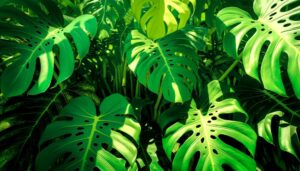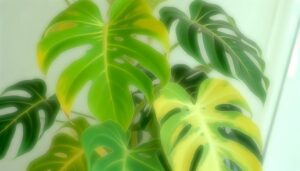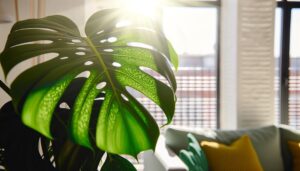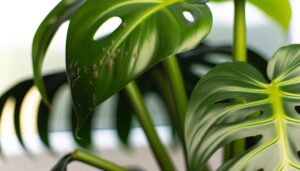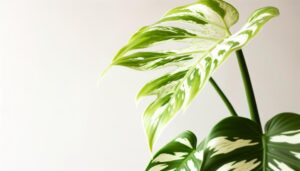Monstera Affinity Lechleriana: Care and Tips!
Monstera Affinity Lechleriana, native to Central and South America, features elaborate leaf patterns evolved for optimal light capture and wind resistance. This plant thrives in bright, indirect light, but adapts to lower levels, making it versatile for indoor conditions.
Ensure well-draining soil rich in organic matter, incorporating peat moss, perlite, and orchid bark. Water consistently while keeping the soil moist but not waterlogged.
Regular pruning of yellowing or damaged parts promotes healthy growth. Monitor for common pests like spider mites and aphids, using insecticidal soaps or neem oil for management.
Discover comprehensive care strategies for your Monstera.
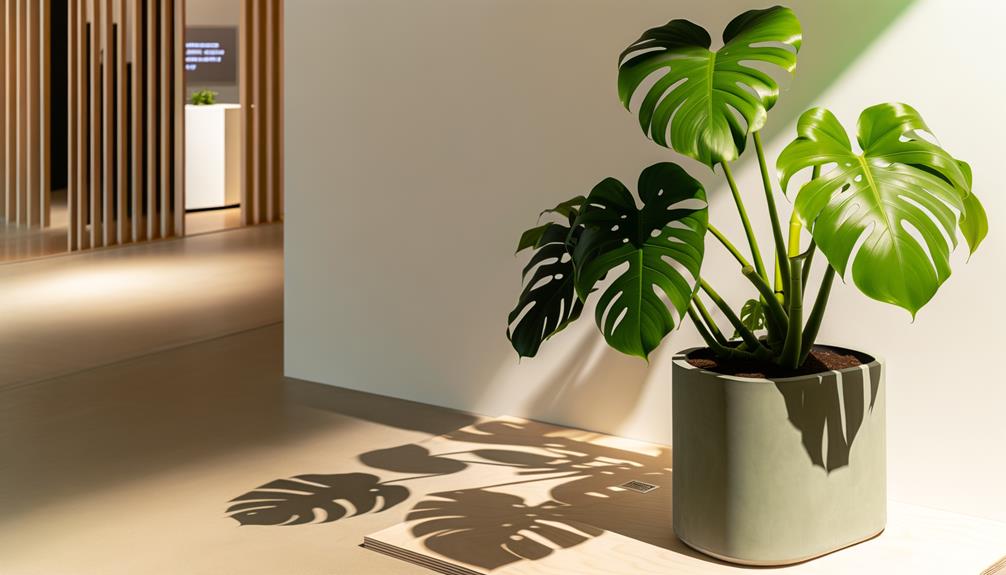
Key Takeaways
- Native to Central and South America, used in traditional medicine and crafts.
- Unique leaf patterns optimize photosynthesis, wind resistance, and water shedding.
- Thrives in bright, indirect light but adaptable to lower light conditions.
- Requires well-draining soil with peat moss, perlite, and orchid bark.
- Susceptible to pests like spider mites and mealybugs; regular inspection and control essential.
Origin and History
The Monstera Affinity Lechleriana, native to the tropical rainforests of Central and South America, has a rich history intertwined with indigenous cultures and botanical studies. You’ll find that indigenous peoples utilized its aerial roots for traditional medicine and basket weaving.
Early botanists, captivated by its unique epiphytic growth, documented its ecological role within the rainforest understory. The plant’s adaptability to varying light conditions has fascinated researchers, leading to extensive studies on its photosynthetic efficiency.
You’ll appreciate that historical botanical expeditions often prioritized this species, noting its resilience and ornamental appeal. Today, it remains a subject of scientific interest, with ongoing research focusing on its phylogenetic relationships within the Monstera genus.
Unique Leaf Patterns
Characterized by intricate fenestrations and varying degrees of perforation, Monstera Affinity Lechleriana’s leaf patterns demonstrate an evolutionary adaptation that maximizes light capture and minimizes wind damage in its native rainforest habitat.
You’ll observe that these fenestrations serve several biological purposes:
- Enhanced Photosynthesis: The perforations allow sunlight to penetrate deeper into the forest understory, boosting photosynthesis.
- Wind Resistance: The holes reduce wind resistance, preventing leaf tearing during strong gusts.
- Water Shedding: The unique leaf structure facilitates efficient water drainage, reducing fungal growth.
These patterns aren’t merely decorative; they’re essential for the plant’s survival.
Light Requirements
When considering light requirements for Monstera Affinity Lechleriana, you’ll need to balance between ideal sunlight conditions and shade tolerance limits.
This species thrives in bright, indirect light, which facilitates photosynthetic efficiency and robust growth. However, it’s also adaptable to lower light levels, though extended periods in deep shade can impede its physiological development and overall health.
Optimal Sunlight Conditions
Ensuring your Monstera Lechleriana thrives requires understanding its need for bright, indirect sunlight to mimic its natural rainforest habitat. This species relies on dappled light filtering through the canopy, avoiding direct sun exposure that can scorch its leaves.
To enhance light conditions:
- Positioning: Place your plant near an east-facing window for morning sunlight or a north-facing window for consistent, indirect light.
- Lighting Devices: Employ grow lights with a spectrum of 4000-5000 Kelvin if natural light is insufficient, ensuring 12-16 hours of light per day.
- Light Meter Usage: Utilize a light meter to measure 1000-2000 foot-candles, providing the precise light intensity for best growth.
Shade Tolerance Limits
Although Monstera Lechleriana can tolerate lower light conditions, it requires a minimum of 50-100 foot-candles to maintain healthy growth and prevent etiolation. You should make sure your plant receives indirect, filtered light to replicate its natural understory habitat.
Insufficient light will prompt elongation of internodes and reduced leaf fenestration, compromising the plant’s aesthetic and physiological health. Utilize a light meter to measure ambient light levels accurately. If natural light is inadequate, supplement with full-spectrum grow lights to achieve the required intensity.
Avoid direct sunlight as it can cause photodamage, evidenced by leaf scorching or chlorosis. By adhering to these guidelines, you’ll optimize Monstera Lechleriana’s photosynthetic efficiency and overall vigor, ensuring robust and lush foliage.
Watering Guidelines
Consistently monitor the soil moisture to ensure your Monstera Affinity Lechleriana receives the best amount of water for healthy growth. Aim for a balance where the soil remains consistently moist but not waterlogged. Overwatering risks root rot, while underwatering can lead to leaf browning.
To achieve the ideal watering:
- Check soil moisture: Insert your finger about an inch deep into the soil. Water when the top inch feels dry.
- Water thoroughly: Make sure water reaches the root zone by watering until it drains out of the bottom.
- Adjust seasonally: In winter, reduce watering frequency as growth slows, while during the growing season, you may need to water more often.
Ideal Soil Type
Achieving best watering practices goes hand-in-hand with selecting the ideal soil type, which should be well-draining, aerated, and rich in organic matter to support Monstera Affinity Lechleriana’s root health. You should use a mix containing components like peat moss, perlite, and orchid bark. These elements balance moisture retention and drainage, preventing root rot while ensuring adequate oxygenation.
Here’s a quick reference table for soil components:
| Component | Function | Ratio |
|---|---|---|
| Peat Moss | Moisture Retention | 40% |
| Perlite | Aeration and Drainage | 30% |
| Orchid Bark | Organic Matter and Air | 30% |
Temperature and Humidity
Maintaining the appropriate temperature and humidity levels is essential for optimizing the growth and health of Monstera Affinity Lechleriana. Aim for temperatures between 65°F and 80°F (18°C to 27°C) to promote robust development. Avoid exposing the plant to temperatures below 55°F (13°C), as this can cause physiological stress.
Humidity should be kept high, ideally between 60% and 80%. You can achieve this by:
- Utilizing a humidifier: This guarantees consistent humidity levels.
- Placing a tray of water near the plant: Evaporation increases ambient humidity.
- Grouping plants together: This creates a micro-environment with higher humidity.
Monitoring environmental conditions closely will prevent issues like leaf browning and encourage vigorous growth.
Fertilizing Tips
When fertilizing Monstera Affinity Lechleriana, you should choose a balanced, water-soluble fertilizer with a 20-20-20 NPK ratio.
Apply the fertilizer every 4-6 weeks during the growing season to maximize nutrient absorption.
Monitor the plant’s response and adjust the frequency accordingly to prevent nutrient imbalances.
Optimal Fertilizer Choice
For best development, you should use a balanced, water-soluble fertilizer with an N-P-K ratio of 20-20-20 to guarantee your Monstera Lechleriana receives essential nutrients. This promotes an optimal distribution of nitrogen, phosphorus, and potassium, vital for strong foliage, root development, and overall health.
To apply effectively:
- Dilution: Mix the fertilizer at half the recommended strength to prevent nutrient burn.
- Application: Evenly distribute the solution during the plant’s active growth phase to ensure thorough nutrient absorption.
- Monitoring: Regularly check for signs of over-fertilization, such as leaf yellowing or browning, to adjust the dosage accordingly.
Feeding Frequency Tips
To ensure your Monstera Lechleriana thrives, apply fertilizer every 4-6 weeks during the active growing season. Utilize a balanced, water-soluble fertilizer with an N-P-K ratio of 20-20-20. Dilute the fertilizer to half strength to prevent root burn, ensuring peak nutrient absorption.
Monitor for signs of nutrient deficiency, such as chlorosis or stunted growth, which indicate the need for more frequent feeding.
During the dormant period, reduce feeding to every 8-10 weeks, as the plant’s metabolic rate decreases. Always water the soil before applying fertilizer to avoid root damage.
Adhering to this regimen supports robust leaf development and overall plant health, enhancing the Monstera Lechleriana’s aesthetic appeal and longevity.
Pruning Techniques
Trimming your Monstera Affinity Lechleriana promotes healthy growth and maintains the plant’s aesthetic appeal by removing dead or damaged leaves and stems.
To achieve best results, follow these steps:
- Identify targets: Locate yellowing, browning, or damaged leaves and stems. These parts drain energy from the plant and hinder new growth.
- Sterilize tools: Use disinfected pruning shears to cut, minimizing the risk of infections. Disinfect with isopropyl alcohol before and after each use.
- Cut strategically: Make precise cuts just above a node or at the base of the stem. This encourages new growth in the correct direction and maintains the plant’s structure.
Regular pruning guarantees your Monstera Affinity Lechleriana remains vibrant and free from potential growth inhibitors.
Common Pests and Diseases
Your Monstera Affinity Lechleriana is vulnerable to common pests like spider mites, mealybugs, and aphids, which can compromise its health and vigor if not promptly addressed. Spider mites cause stippling and yellowing by feeding on cell sap, while mealybugs secrete honeydew, fostering sooty mold growth. Aphids, vectors of viral diseases, distort new growth by extracting plant juices.
To alleviate these threats, inspect your plant regularly, especially the undersides of leaves. Use insecticidal soap or neem oil for control; systemic insecticides may be necessary for severe infestations.
Additionally, fungal pathogens like powdery mildew and root rot can manifest under high humidity and poor drainage. Ensure optimal air flow and well-draining soil to prevent these diseases. Regular monitoring is key to maintaining plant health.
Conclusion
To sum up, mastering the care of Monstera lechleriana will reward you with its striking foliage and robust growth. Remember, this species thrives with bright, indirect light, consistent watering, and well-draining soil.
Intriguingly, a study highlighted that Monstera plants can improve indoor air quality by up to 20%. By following ideal temperature, humidity, and fertilization practices, you’ll maximize your plant’s health.
Regular pruning and vigilance against pests will further enhance its longevity and vibrancy.


